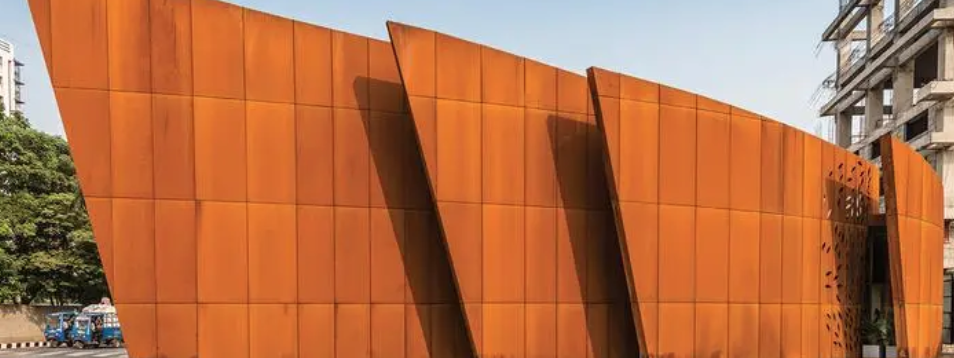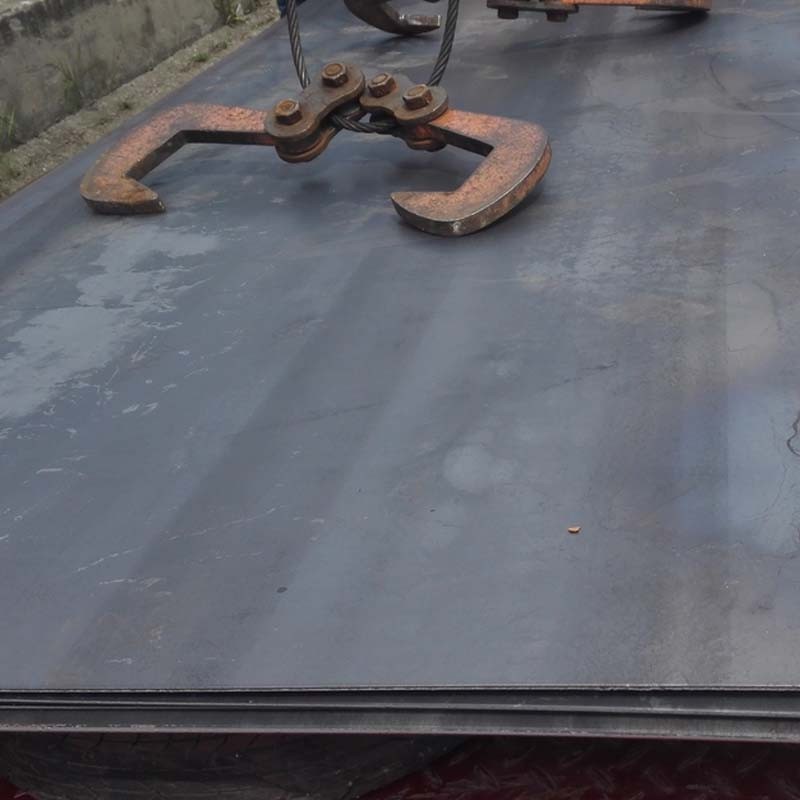The development of weathering steel plate dates back to the 1930s when United States Steel Corporation (USS) first introduced it under the brand name "Cor-Ten" (corrosion resistance and tensile strength). The alloying elements in weathering steel, primarily copper, chromium, nickel, and phosphorus, promote the formation of a stable, adherent oxide layer on the surface, known as the patina. This patina acts as a protective barrier against further corrosion and reduces the need for traditional protective coatings, such as painting.
Key characteristics and advantages of weathering steel plate include:
Enhanced Weather Resistance:
Weathering steel is highly resistant to atmospheric corrosion, including the effects of rain, snow, humidity, and salt air in coastal environments. This makes it ideal for outdoor and exposed applications, such as bridges, buildings, sculptures, and railway rolling stock.
Cost-Effective:
Although weathering steel may initially cost more than traditional carbon steel, it can provide long-term cost savings due to its reduced maintenance requirements and the elimination of the need for periodic repainting.
Aesthetically Pleasing:
The naturally developed rust-like appearance of weathering steel plate creates a distinctive and aesthetically pleasing look, often used in modern architectural designs to blend with the natural environment.
High Strength:
Weathering steel offers good mechanical properties, including high tensile strength and yield strength, making it suitable for structural applications.
Low Maintenance:
Weathering steel forms a self-repairing protective layer, which means maintenance is generally limited to periodic cleaning rather than extensive surface treatment.
Environmental Benefits:
Weathering steel is considered environmentally friendly since it reduces the use of protective coatings and prolongs the life cycle of structures, leading to lower resource consumption and waste generation.
Weathering steel is mainly used for steel frame structures that are exposed to the air for a long time, such as railways, vehicles, bridges, towers, solar power, and high-speed projects. It is used to manufacture shipping containers, railway vehicles, crude oil derricks, port constructions, service platforms of oil production plants, and containers for sulfur-etched substances in petroleum equipment in chemical plants.
Main uses of weathering steel
As a new generation of steel raw materials, weathering steel has air corrosion resistance 2 to 5 times that of carbon structural steel, and the longer the service time, the more prominent the corrosion resistance effect. Because of its characteristics of rust resistance, spray-free, thinning, energy saving and consumption reduction, time saving, environmental protection and energy saving, it can be applied to steel frame structures that are exposed to the air for a long time, such as engineering buildings, vehicles, road bridges, and towers. To produce components such as shipping containers, railway vehicles, crude oil derricks, port engineering buildings, and oil production plant service platforms.
Cutting of weathering steel
When weathering steel is used, it needs to be cut, and it should also be designed and planned according to the engineering drawings. The material of weathering steel is relatively unique, the material is relatively good, it has relatively hard strength and toughness, and it plays a huge role in design and application!
Weathering steel is a material of steel. It is a high-alloy steel (C<0.2%), with good comprehensive performance, good ultra-low temperature characteristics, good stamping characteristics, electric welding characteristics and good machinability. Widely used in highway bridges, vehicles, ships, engineering construction, high pressure vessels, etc. Q means the compromise of this material, and the 345 in the back refers to the compromise value of this material, which is around 345MPa.
It's important to note that while weathering steel plate provides excellent weather resistance, it may not be suitable for certain aggressive environments or conditions. Designers and engineers should consider the specific requirements of a project and consult relevant standards and guidelines before selecting weathering steel or any other construction material.
In China, weathering steel plates are commonly manufactured and specified in accordance with Chinese national standards, known as GB/T (Guo Biao Tuijian) standards. The main GB/T standard for weathering steel plates is:
GB/T 4171-2008: This standard specifies the size, shape, weight, technical requirements, test methods, inspection rules, packaging, marking, and quality certificates for weathering steel plates used in welded structures and other high-strength low-alloy structural steels.
GB/T 4171 includes several weathering steel grades, such as Q235NH, Q265GNH, Q295NH, Q310GNH, Q355NH, Q415NH, Q460NH, Q500NH, Q550NH, and Q600NH. Each grade is designed to provide enhanced resistance to atmospheric corrosion and is suitable for various structural and engineering applications in China.
Chinese weathering steel plates manufactured in compliance with GB/T 4171-2008 are known for their good mechanical properties and excellent weather resistance. They are widely used in bridge construction, railway vehicles, buildings, and other outdoor structures exposed to the elements.
When dealing with weathering steel plates in China, referring to GB/T 4171-2008 is crucial to ensure that the materials meet the required standards and specifications. Designers, engineers, and manufacturers should carefully select the appropriate weathering steel grade from this standard based on the specific project requirements, environmental conditions, and structural considerations.
It's important to note that while GB/T 4171-2008 is the primary national standard for weathering steel plates in China, other international standards, such as ASTM or EN, may also be referenced or used for specific projects in the country. However, GB/T 4171-2008 provides the comprehensive guidelines for weathering steel plates manufactured and used in China.
In the United States, weathering steel plates are typically manufactured and used in accordance with several industry standards and specifications that ensure their quality, performance, and suitability for various applications. Some of the key standards for weathering steel plates in the US include:
ASTM A588/A588M: This specification covers high-strength, low-alloy structural steel shapes, plates, and bars for welded, riveted, or bolted construction with atmospheric corrosion resistance. ASTM A588/A588M Grade A and Grade B are the most commonly used weathering steel grades in this standard.
ASTM A709/A709M: This specification covers carbon and high-strength low-alloy steel structural shapes, plates, and bars intended for use in bridges. The atmospheric corrosion resistance of the steel in most environments is substantially better than that of carbon structural steels with or without copper addition. ASTM A709/A709M Grade 50W is the weathering steel grade often used for bridges.
ASTM A242/A242M: This specification covers high-strength low-alloy structural steel shapes, plates, and bars for welded, riveted, or bolted construction intended primarily for use as structural members where savings in weight [mass] or added durability are important. ASTM A242/A242M Type 1 is the commonly used weathering steel grade in this standard.
These standards outline the chemical composition, mechanical properties, and other relevant characteristics of weathering steel plates. They also specify the testing and inspection methods to ensure the plates meet the required performance criteria.
In the United Kingdom, weathering steel plates are used and specified in accordance with various British Standards (BS) and European Standards (EN) that define the requirements for these materials. The most common standard for weathering steel plates in the UK is:
BS EN 10025-5: This European Standard specifies the requirements for flat and long products of hot-rolled structural steels with improved atmospheric corrosion resistance. It includes several weathering steel grades, such as S235J0W, S235J2W, S355J0WP, S355J2WP, S355J0W, S355J2W, and S355K2W.
BS EN 10025-5 outlines the chemical composition, mechanical properties, and delivery conditions for weathering steel plates intended for use in welded, bolted, and riveted structures subjected to atmospheric corrosion.
It's important to note that the UK often adopts European Standards (EN) as British Standards (BS EN) to harmonize with other European countries. Therefore, BS EN 10025-5 is the standard that should be referenced when dealing with weathering steel plates in the UK.
In Japan, weathering steel plates are commonly used and specified in accordance with Japanese Industrial Standards (JIS) that define the requirements for these materials. The main JIS standard for weathering steel plates is:
JIS G 3125: This Japanese Industrial Standard specifies superior atmospheric corrosion-resistant rolled steels. It includes several weathering steel grades, such as SPA-H, SPA-C, and SMA (e.g., SMA400AW, SMA490AW, SMA570W), which are designed to provide high resistance to atmospheric corrosion.
JIS G 3125 outlines the chemical composition, mechanical properties, dimensions, tolerances, and other relevant characteristics of weathering steel plates. These plates are primarily used in welded structures and other applications exposed to the elements in Japan.
When dealing with weathering steel plates in Japan, referring to JIS G 3125 is essential to ensure the proper material selection and compliance with industry standards. Designers, engineers, and manufacturers should carefully choose the appropriate weathering steel grade from this standard based on the specific requirements and environmental conditions of the project.
It is also important to note that Japan may use other international standards or specifications, such as ASTM or EN, for specific projects or applications. However, JIS G 3125 is the primary standard used in Japan for weathering steel plates, and it provides a comprehensive set of guidelines for these materials in various construction and engineering applications.
| Grade | Thickness Or Diameter(mm) |
| Q235NH | Steel Plate/Steel Strip | Steel |
| Q295NH | ≤100 | ≤ |
| Q295GNH | ≤100 | ≤ |
| Q355NH | ≤20 | ≤ |
| Q355GNH | ≤100 | ≤ |
| Q415NH | ≤20 | ≤ |
| Q460NH | ≤60 | - |
| Q500NH | ≤60 | - |
| Q550NH | ≤60 | - |
| Q265GNH | ≤3.5 | - |
| Q310GNH | ≤3.5 | - |
Weathering steel plate is a high-strength, weather-resistant, corrosion-resistant, low-alloy structural steel. Its main feature is good weather resistance, and it can be used for a long time in an environment with a low degree of oxidation. Its corrosion rate is about twice that of ordinary steel plates. It also has excellent atmospheric corrosion resistance, good local corrosion resistance and ductility, Weldability etc. Therefore, it is widely used in automobiles, bridges, railways, construction and other fields.
1. Specifications of SPA-H weather-resistant steel plate: thickness 1.5-19mm, width 800-1600mm, length 1000-12000mm.
2. Specifications of SPA-C weathering steel plate: thickness 1.5-19mm, width 800-1600mm, length 1000-12000mm.
3. SMA400AW weather-resistant steel plate specifications: thickness 1.5-200mm, width 900-4500mm, length 3000-18000mm.
4. Specifications of SMA490AW weather-resistant steel plate: thickness 1.5-200mm, width 900-4500mm, length 3000-18000mm.
5. Specifications of SMA570W weather-resistant steel plate: thickness 1.5-200mm, width 900-4500mm, length 3000-18000mm.
The above are the common specifications of weather-resistant steel plates. Different specifications of weather-resistant steel plates are suitable for different fields and needs.












